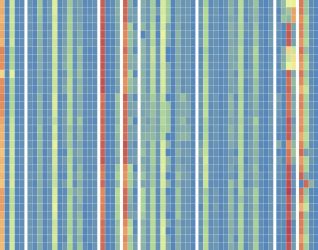Mass spectrometry is one of the key items in the tool belts of twenty-first century scientists, from physical scientists and chemists to biologists and medical researchers. Finding new ways to put the technology to use has the potential to provide profound insights into the composition of myriad substances and change how many researchers do science.

One such researcher is John Denu, Epigenetics theme leader at the Wisconsin Institute for Discovery. Denu, whose work examines how chromatin regulates gene expression, utilizes mass spectrometry as an important tool for understanding the mechanisms underlying epigenetic variations.
Mass spectrometry is a technique that relies on known characteristics of atoms and molecules to discover the specific chemical composition of a given substance. By ionizing a sample and separating the ions according to their mass-to-charge ratio, a mass spectrometry instrument allows researchers to identify atoms or molecules based on the relative abundances of ions and their masses. Proteins, for example, can be analyzed and identified based on their constituent parts using proteomic mass spectrometry. The potential for applications for such precise chemical identification of substances is boundless.
Denu’s group acquired their first “mass spec” instrument when they moved into the Discovery Building and became a part of the nascent Wisconsin Institute for Discovery in 2011. Since then, Denu and his colleagues have been working hard to design unique proteomics workflows for studying chromatin – made up of DNA, RNA, and proteins – using mass spectrometry.
In concert with several collaborators, Denu has developed a method to analyze histones, key proteins involved in epigenetic regulation. Histones are proteins around which DNA winds inside the nucleus of a cell, and the particular ways in which histones, wind, unwind, and are modified can dictate which parts of the genome are expressed and when. “It’s a way to assess aspects of the epigenome using this proteomic workflow,” says Denu. “We can quantify about 70 unique types of modified states of chromatin.”
“We knew this was going to be an important component of moving the field forward, developing a robust method for querying the epigenome of histones.”
This novel approach, which Denu has dubbed “histone-typing,” is a significant step in the developing field of epigenetics. “We knew this was going to be an important component of moving the field forward, developing a robust method for querying the epigenome of histones,” contends Denu. It has led to a number of new lines of inquiry and numerous collaborations. So much so, in fact, that the Epigenetics theme’s proteomics mass spectrometer is operating at capacity.
Collaborators across campus are working with Denu and his team to use his histone-typing workflow for a variety of projects including the epigenetics effects of anti-cancer reagents, plant-related epigenetic developmental questions, effects of the microbiome on host epigenetics, and many more. “People are coming to us for collaborations because we can do this. We may have bit off more than we can chew,” Denu says, laughing.
In one very successful collaborative effort, Denu has teamed up with the UW School of Medicine and Public Health to study the genetic and epigenetic alterations involved with tumorigenesis and cancer progression. The Department of Urology’s Dr. David Jarrard and the Department of Surgery’s Dr. Lee Wilke, together with Denu, have proposed use of histone-typing to describe how epigenetic modifications of histone proteins modulate cancer biology, possibly informing personalized, precision cancer care.

Another developing collaboration involves a UW-Madison researcher who is no stranger to mass spectrometry. Associate Professor of Biochemistry Dave Pagliarini, director of the Morgridge Institute for Research’s Metabolism Initiative, has been working to elevate the scope and capacity of mass spectrometry at UW-Madison through development of a new campus resource housed in the Biotechnology Center. One of Pagliarini’s investigations into iron deficiencies turns out to have a sizable epigenetic component that could be explored using Denu’s histone-typing method. According to Pagliarini, “the Denu group’s development of mass spec-based tools to analyze histone modifications has been a real boon to our work. Collaborating with John’s team helped us to discover that iron deprivation alters mitochondrial metabolism in large part through epigenetic regulation. We wouldn’t have explored this area had it not been for John’s development of this technique and his eagerness to work together.”
Denu intends to continue working with Pagliarini on future projects to understand how metabolism informs the epigenome, an effort that will be assisted by the acquisition of a new mass spectrometry instrument supported by a joint grant with Professor of Medical Microbiology and Immunology Nancy Keller. The new machine will be dedicated to studying the metabolome and the chemical transformations that are necessary for cellular processes. Denu is particularly interested in quantifying a phenomenon known as metabolite flux and understanding its consequent epigenetic changes.
Where the proteomics mass spectrometry machine has helped Denu characterize modified histones, the new metabolomics instrument, along with Denu’s histone-typing methods, will help reveal the story of how those alterations occur. “How does glucose end up on histones? How do methyl groups end up on chromatin?” asks Denu. Mass spectrometry will help Denu and other researchers trace the path from metabolism to chromatin and epigenetic information. “This will be a way to quantitatively assess how the chemicals of metabolism actually influence pathways at the level of gene expression and chromatin,” he says.
“This will be a way to quantitatively assess how the chemicals of metabolism actually influence pathways at the level of gene expression and chromatin.”
Denu is also confident that his methods will be utilized by collaborators who are interested in related questions. While the mass spectrometry machines acquired with grant funding by Denu’s group are not core facilities in the same way as the Biotechnology Center’s instruments are, the unique way they are being used to make epigenetic discoveries may be very useful to a broad range of researchers who may be able to use Denu’s specialized workflows.
“The mass spec-based inquiry on this campus is massive,” says Denu, noting that while the machines used in his group do not constitute a core or a center, much of their work can be easily transferred to other similar applications. “We’re adapting instruments for specialized types of analyses,” meaning that having mass spectrometry machines in-house and biologically tuned to answer epigenetic questions is a vital component of the work being done in the Epigenetics theme at WID.
With ever-growing mass spectrometry capabilities both in his lab and in the broader UW-Madison community, Denu is keen on moving the field of epigenetics forward while simultaneously advancing the goals of colleagues in other disciplines. As new methods in mass spectrometry bring the ambiguities of chromatin into clearer focus, Denu and his team are poised to make discoveries about the impact of factors ranging from gut microbiota to environment and social elements on genetic expression while also developing insights into metabolism, neuronal diseases, cancer diagnosis and treatment, and more. The possibilities, according to Denu, are endless: “there are plenty of opportunities to grow.”
— Nolan Lendved


You must be logged in to post a comment.